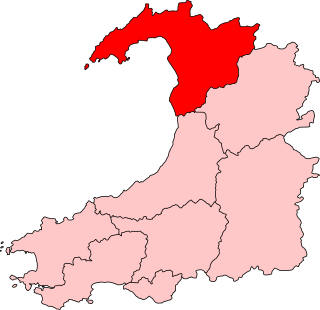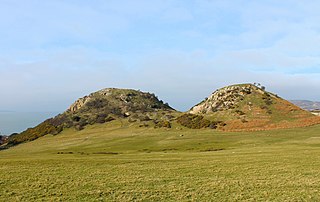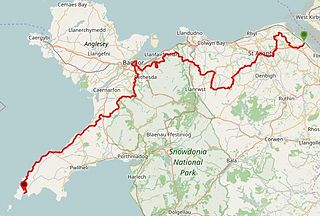Llangelynnin may refer to:
- Llangelynnin, Conwy, a former parish in Conwy County Borough, Wales
- Llangelynnin, Gwynedd, a village and community in Gwynedd, Wales
Llangelynnin may refer to:

Llywelyn ap Gruffudd, sometimes written as Llywelyn ap Gruffydd, also known as Llywelyn the Last, was the native Prince of Wales from 1258 until his death at Cilmeri in 1282. Llywelyn was the son of Gruffydd ap Llywelyn Fawr and grandson of Llywelyn the Great, and he was one of the last native and independent princes of Wales before its conquest by Edward I of England and English rule in Wales that followed, until Owain Glyndŵr held the title during the Welsh Revolt of 1400–1415.

Gwynedd is a county in the north-west of Wales. It borders Anglesey across the Menai Strait to the north, Conwy, Denbighshire, and Powys to the east, Ceredigion over the Dyfi estuary to the south, and the Irish Sea to the west. The city of Bangor is the largest settlement, and the administrative centre is Caernarfon. The preserved county of Gwynedd, which is used for ceremonial purposes, includes the Isle of Anglesey.

Caernarfonshire, sometimes spelled Caernarvonshire or Carnarvonshire, is one of the thirteen historic counties, a vice-county and a former administrative county of Wales.

Conwy, previously known in English as Conway, is a walled market town, community and the administrative centre of Conwy County Borough in North Wales. The walled town and castle stand on the west bank of the River Conwy, facing Deganwy on the east bank. The town formerly lay in Gwynedd and prior to that in Caernarfonshire. The community, which also includes Deganwy and Llandudno Junction, had a population of 14,753 at the 2011 census.

North Wales is a region of Wales, encompassing its northernmost areas. It borders mid Wales to the south, England to the east, and the Irish Sea to the north and west. The area is highly mountainous and rural, with Snowdonia National Park and the Clwydian Range and Dee Valley, known for its mountains, waterfalls and trails, wholly within the region. Its population is concentrated in the north-east and northern coastal areas, with significant Welsh-speaking populations in its western and rural areas. North Wales is imprecisely defined, lacking any exact definition or administrative structure. It is commonly defined administratively as its six most northern principal areas, but other definitions exist, with Montgomeryshire historically considered to be part of the region.
Dafydd ab Owain Gwynedd was Prince of Gwynedd from 1170 to 1195. For a time he ruled jointly with his brothers Maelgwn ab Owain Gwynedd and Rhodri ab Owain Gwynedd.

Deganwy is a town and electoral ward in Conwy County Borough in Wales with a population of 3,936 (2011). It lies in the Creuddyn Peninsula alongside Llandudno and Rhos-on-Sea. Historically part of Caernarfonshire, the peninsula is in a region of north Wales where as many as 1 in 3 of residents are able to speak Welsh, and is home to some of the most expensive streets in Wales. Deganwy is located to the east of the town of Conwy and with it forms the Conwy community. The name Deganwy has been interpreted in modern times as Din-Gonwy, which would mean "Fort on the River Conwy", but the historical spellings make it impossible for this to be the actual origin of the name although mentioned in Domesday Book is "the territory of the Decanae tribe". The original wooden castle was rebuilt in stone after 1210. Deganwy is in the ecclesiastical parish of Llanrhos, and has a Victorian era Gothic parish church dedicated to All Saints.
Betws or Bettws may refer to:
Rhos is a region to the east of the River Conwy in north Wales. It started as a minor kingdom then became a medieval cantref, and was usually part of the Kingdom of Gwynedd.

Llanrhychwyn is a hamlet in Conwy county borough, Wales. It lies in the Conwy valley, less than a mile south of Trefriw, and a mile north-west of Llanrwst. Today neighbouring Trefriw is a village with a population of around 600, but in the time of Llywelyn Fawr, and up to the early 19th century, Llanrhychwyn was larger than Trefriw, which consisted simply of "a few houses here and there". Indeed, even today both Trefriw and Llanrhychwyn lie within the parish of Llanrhychwyn. The area around Llanrhychwyn had a population of only 178 in 2011.
Nant Conwy was a rural district in the administrative county of Caernarfonshire from 1934 to 1974. The district was formed by a County Review Order, combining the areas of Geirionydd Rural District with most of Conwy Rural District and part of Ogwen Rural District. The name is derived from Nant Conwy, an historic cwmwd of the Kingdom of Gwynedd in the cantref of Arllechwedd.

Dwyfor Meirionnydd is a constituency of the Senedd, first created for the former Assembly's 2007 election. It elects one Member of the Senedd by the first past the post method of election. Also, however, it is one of eight constituencies in the Mid and West Wales electoral region, which elects four additional members, in addition to nine constituency members, to produce a degree of proportional representation for the region as a whole.

Llangelynnin is a former parish in the Conwy valley, in Conwy county borough, north Wales. Today the name exists only in connection with the church, a school in the nearby village of Henryd, and the nearby mountain ridge, Craig Celynnin.

Henryd is a village and community on the western slopes of the Conwy valley in Conwy county borough, north Wales. It lies about 2 miles (3.2 km) south of Conwy, off the B5106 road. At the 2001 census, it had a population of 594, increasing to 715 at the 2011 census.

Deganwy Castle was an early stronghold of Gwynedd and lies in Deganwy at the mouth of the River Conwy in Conwy, north Wales. It lies at an elevation of 110 m (361 ft) on a volcanic plug.

Llangelynnin is a small village and community near Tywyn, Gwynedd, Wales. Although the village is usually known as Llangelynnin in English, the community name used was Llangelynin though now its also "Llangelynnin".
Rhiw may refer to:
Moelfre may refer to:

The North Wales Pilgrim's Way is a long-distance walking route in North Wales, running from near Holywell in the east to Bardsey Island in the west. The first half of the trail takes an inland route, with the second half following the north coast of the Llŷn Peninsula. It measures 133.9 miles (215 km) in length, and was officially launched at Porth y Swnt, Aberdaron on 10 July 2014.

The 2022 Gwynedd Council election took place on 5 May 2022 to elect 69 members from 65 wards to Gwynedd Council. On the same day, elections were held to the other 21 local authorities and to community councils in Wales as part of the 2022 Welsh local elections. The previous Gwynedd all-council election took place in May 2017 and future elections will take place every five years.